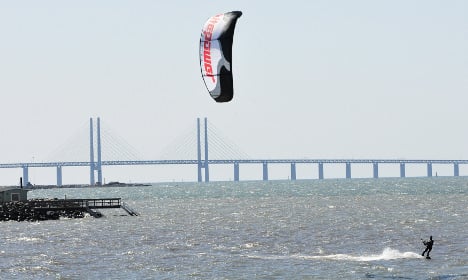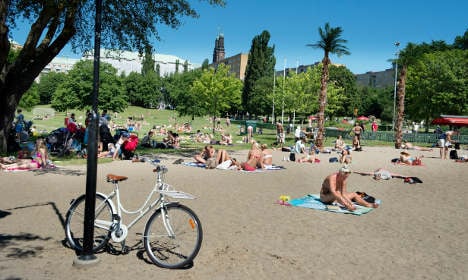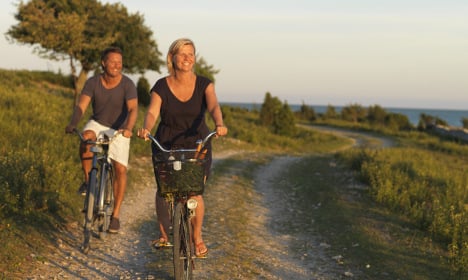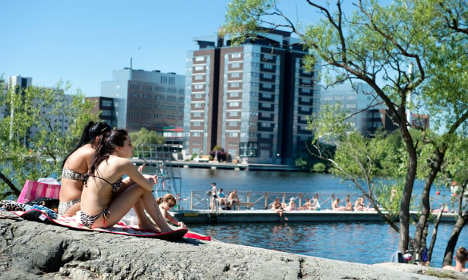1. Ribersborg, Malmö
Wooden piers jut out into shallow waters at city beach Ribersborg in downtown Malmö, which has everything a visitor could ask for: restaurants, showers, green areas and barbecues. It also caters for nudists and dogs who can each enjoy their own separate stretches of sand.
Admire the impressive skyline of Sweden's third biggest city, gaze at Copenhagen across the Öresund strait and casually stroll past the property that used to belong to Swedish footballer Zlatan Ibrahimovic less than five minutes away while doing your best not to look too starstruck.
Don't forget to impress your southern Swedish friends by calling it by its local nickname, 'Ribban'. Top it off by suggesting you go back in winter when the beach centre offers bathing opportunities complete with sauna facilities.

Ribersborg with the Öresund bridge in the background. Photo: Johan Nilsson/SCANPIX
2. Tanto Beach, Stockholm
If you're looking for a Stockholmer on a hot summer's day, chances are you'll find them here.
This is the perfect place to savour those long, Swedish summer nights. Prepare to be blown away by the facts that 1) it's nearly midnight, 2) the sun has yet to set, and 3) you're going for a swim in the city centre of a European capital.
Tanto Beach does not have any barbecue facilities, but some of Södermalm district's trendiest eateries and takeaways are readily available within walking distance. Why not round off the evening with a drink at one of Stockholm's hottest outdoor bars or restaurants?

Tanto Beach in Stockholm. Yes, that's a palm tree in the background. Photo: Jessica Gow/TT
3. Fårö, Gotland
Fårö is an island off an island. Located some 200 kilometres south of Stockholm, it is reached by ferry from Gotland, which in turn can be reached by ferry or plane from mainland Sweden.
Sudersand is Fårö's – and Gotland's – most beautiful and popular beach. It has a little bit of everything for everyone, from the backpacker seeking unspoiled sands to the young family looking for leisure activities to the Russian soldier looking for a good spot from which to launch a seaborne invasion (just kidding!).
With pedal boats for hire, a mini golf course, restaurants, cafés, kiosks and ice cream bars on the beach, visitors have plenty to keep them busy should they tire of the long, wide stretches of soft sand. But why should they?

There are plenty of activities to enjoy on Fårö. Photo: Michael Jonsson/Folio/imagebank.sweden.se
4. Lysekil, Bohuslän
The Bohuslän region in south-western Sweden is known for its abundance of gorgeous beaches with majestic rock formations sloping down to the sea.
The old fishing town of Lysekil alone has a total of 12 beach spots. We tried to pick just one of them, honestly, but it was impossible. Oh well, this summer's as good a time as any to start planning that beach hopping holiday – who knew Sweden would be just the place?
Several glaciation periods during the ice age created the rock faces' polished look, unique to this area. A fun fact to drop into the conversation at parties is that some of Bohuslän's oldest rock species were created 1.8 billion years ago. Get that.

A beach hut near Lysekil. Photo: Andreas Nordström/imagebank.sweden.se
5. Norrfällsviken, Höga Kusten
Bet you never thought you could go for a summer swim north of the 60th parallel? In fact, you will find few places better. Norrfällsviken on Sweden's High Coast (Höga Kusten) is not as crowded as many of the other beaches and, because it's located in northern Sweden, the sun barely sets in summer. Perfect for a midnight skinny dip, in other words.
And when you're lying outstretched on its golden swathes of sandy beach, enjoying the sunny (most of the time) blue skies and gazing at the green mountains across the water, you can almost fool yourself you're in the Mediterranean.
When you're done, read freelance writer Danny Chapman's guide to some of the other gems Sweden's High Coast has to offer.
The Mediterranean, the Caribbean… or Norrfällsviken in Sweden? Photo: Danny Chapman



 Please whitelist us to continue reading.
Please whitelist us to continue reading.